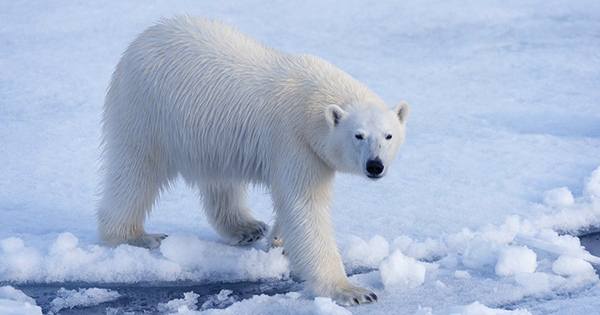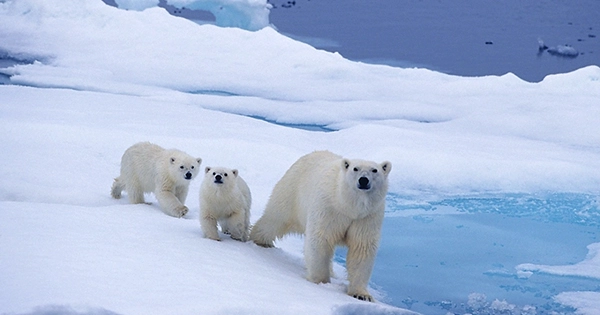International Polar Bear Day is observed on February 27th, and it is a time to celebrate and appreciate one of Earth’s most charismatic yet endangered mammals. We spoke with Geoff York, Senior Director of Conservation for Polar Bears International, about all things baby bears and learned about polar bear den season. What qualities do polar bear mothers want in a good den? Pregnant female polar bears dig their maternity dens in deep banks of snow over most of the Arctic, away from locations where other bears may be hunting and roaming. They usually choose coastal tundra bluffs, riverbanks, lakeshores, and, when possible, mountains, since they improve drifting and store snow for longer.
They also prefer regions that are distant and mostly unaffected by human activity, however, there have been some significant exceptions, such as females denning in close proximity to human activity. Throughout denning, polar bears are busy, scraping ice from the den roof with their claws and manually lifting the den upward to maintain a desirable depth from the surface if snow accumulates above her.

Why is it critical that we maintain track of these dens? One of the most crucial times for polar bear reproduction is during Denning. Cubs are born with light hair, are blind, and are completely reliant on their mother and the den for life. Polar bears in diverse locales find suitable denning habitats, making these sites eligible for possible protection throughout the denning season. They are, by definition, important habitat regions for polar bears.
However, protecting something we can’t see is tough, because polar bear dens are difficult to spot once they’ve been inhabited and buried in drifting snow. Only direct observation (human activity seldom overlaps with denning regions), satellite monitoring, or the use of technology like forward-looking infrared (FLIR) to detect heat under snow may be done. Protecting denning regions is even more important in locations where there is a lot of human activity, such as the northern slope of Alaska. In the last 30 years, the population of the Southern Beaufort Sea, which relies on secure denning habitat along the Alaskan Arctic coast, has decreased by 40%.
The key to stabilizing and then reversing the decrease in successful reproduction. Winter access for tundra vehicles or the construction of temporary ice roads over the tundra is often required for active oil and gas exploration and production activities. These activities may cause direct injury to denning bears by causing disruption that leads to early abandonment, or by causing direct trauma from large vehicles colliding with dens they mistakenly drive-through.
What progress have we achieved in protecting and detecting polar bear dens, and what problems do we currently face? We’ve learned a lot about where polar bears choose to the den, when they arrive, and when they leave thanks to two decades of tracking polar bears across various populations.
We’ve refined den entry and exit timings and learned about bear behavior at den sites thanks to over 20 years of visual den monitoring by PBI and collaborators, giving managers with better data on disturbance reduction. The use of FLIR to locate dens beneath the snow, while originally intriguing, has proven difficult to apply in real-time. According to a recent study of FLIR’s usage as a management tool, it may have missed 55 percent of the dens studied.
While some of this failure might be attributed to poor technique, the small environmental window that FLIR must work inside in order to identify dens is a significant factor. For the delicate heat from a den to become visible on the surface, FLIR requires dark, steady, cold conditions over several days.
The mark is readily erased by new snow, winds, drifting, and sunshine. Those steady meteorological conditions are becoming increasingly elusive as the Arctic continues to warm at roughly three times the rate of the rest of the world. Synthetic aperture radar (SAR), a more robust technology, is being developed by PBI and partners to replace FLIR in active management circumstances. SAR is a surface piercing radar (SPR) that was initially designed for military purposes in identifying things underwater.
It is less weather-dependent, works at a higher altitude, and has a broader view angle, allowing it to scan huge regions of prospective habitat more efficiently. An initial study in Alaska showed promise, but research was hampered by a dearth of recognized dens to test SAR. PBI and Brigham Young University have refined the concept by digging and occupying fake dens in the mountains above Provo, Utah. Last October, we collected SAR footage of known polar bears on the ground in Churchill, Manitoba, to provide the engineers with definitive target data. Our crew is currently en route to Svalbard, Norway, where they will try to locate numerous known dens within the flying range of Longyearbyen.
















